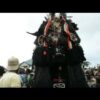Ancestry
EXTREME PUNISHMENTS METED OUT ON SLAVES BY THE ENSLAVERS DURING THE SLAVE TRADE.
EXTREME PUNISHMENTS METED OUT ON SLAVES BY THE SLAVE HOLDERS DURING THE SLAVE TRADE
The slave trade generated incredible wealth for the European and American nations that participated in it—at the expense of millions of human lives. An estimated 1.8 million Africans perished during the Middle Passage.
The countries that enslaved the highest number of Africans, from the most to the least, were Portugal, Britain, France, the Netherlands, Spain, the United States and Denmark—shipping a total of 12.5 million enslaved Africans to toil in what was considered the “New World.”
Enslaved people were punished by whipping, shackling, hanging, beating, burning, mutilation, branding, rape, and imprisonment. Punishment was often meted out in response to disobedience or perceived infractions, but sometimes abuse was performed to re-assert the dominance of the enslaver (or overseer) over the enslaved person.
Pregnancy was not a barrier to punishment; methods were devised to administer lashings without harming the baby; not because they are empathic over the baby but because they need more hands in the field. So the baby is protected and nurtured to grow and work as a slave. Enslavers would dig a hole big enough for the woman’s stomach to lie in and proceed with the lashings.
Slaves were punished for a number of reasons: working too slowly, breaking a law (for example, running away), leaving the plantation without permission, insubordination, impudence as defined by the owner or overseer, or for no reason, to underscore a threat or to assert the owner’s dominance and masculinity. They were often punished for their failure to demonstrate due deference and submission to whites. Slave owners greatly feared slave rebellions. Demonstrating politeness and humility showed that the slave was submitting to the established racial and social order, while failure to follow them, demonstrated insolence and a threat to the social hierarchy. Whites punished slaves publicly to set an example to others.
Punishments towards enslaved people were often brutal. These severe punishments included but were not limited to:
MUZZLES/IRON MASKS
An iron mask and collar were used by the slave traders to keep field workers from running away and to prevent them from eating crops while working. The mask made breathing difficult and, if left on too long, would tear the person’s skin when removed. The mask’s principal purpose was to impose a sense of speechlessness and terror because the mouth served as both a site of muteness and a location of punishment while being utilized by white masters to prevent enslaved Africans from consuming sugar cane or cocoa beans while working on the plantations .This metal mask was used during slavery for 3 main reasons:
- To prevent the slaves from eating fruits such as apples, pineapples, oranges, cashews, bananas, plantains and sugarcanes etc while harvesting them, yet they were made to work consistently in all the plantation farms.
- To stop the slaves from chanting our African spiritual songs. Not only that those our spiritual and war songs affected the slave masters, it also motivated some slaves to rebel and fight back not minding losing their lives.
- To stop slaves form teaching our African local dialects (languages) to their children…whereby destroyed our dialects and forced them to learn foreign languages.
Last but not the least, to starve slaves as a punishment in the slave camps. The mask prevented them from eating or drinking.
Sometimes the slave masters would force an apple (a whole) into the mouths of slaves before they wore the metal mask on them with the padlocks so that they couldn’t talk.
PUNISHMENT COLLAR
Africans resisted enslavement from the point of capture. When enslaved people tried to run away after being captured by the slave traders, this heavy iron collar was placed on them and weight of fifty-six pounds fastened to the chain, to inflict punishment. The collars are formed with two, three, or four projections. It stopped them from running away again as the spiked ends prevent the wearer from moving into any areas with trees or bushes. Punishment collars such as these clearly marked out a person as having transgressed in some way and were often used to punish other crimes such as theft. The four spikes sticking out, would have made it impossible for a person wearing it to lie down or to lean up against any surface.
PICKET SCARRING
Sometimes as a mode of punishment, slaves were put on pickets long enough to scar their foots and hands. A negro man, in Jamaica, (says Dr. Harrison) was put on the picket so long, as to cause a mortification of his foot and hand, on suspicion of robbing his master, a public officer, of a sum of money, which it afterwards appeared the master had taken himself. Yet the master was privy to the punishment, and the slave had no compensation.
WHIPPING
The cow-skin whip is made entirely of untanned, but dried, ox hide, and is about as hard as a piece of well-seasoned live oak. It is made of various sizes, but the usual length is about three feet. The part held in the hand is nearly an inch in thickness; and, from the extreme end of the butt or handle, the cow-skin tapers its whole length to a point. This makes it quite elastic and springy. A blow with it, on the hardest back, will gash the flesh, and make the blood start. Cow-skins are painted red, blue and green, and are the favorite slave whip. It condenses the whole strength of the arm to a single point, and comes with a spring that makes the air whistle. It is a terrible instrument, and is so handy, that the overseer can always have it on his person, and ready for use. The temptation to use it is ever strong; and an overseer can, if disposed, always have cause for using it. More cruel slave masters go on to apply salts on the wounds of the slaves, incurred by the whip.
BRANDING
The branding of slaves for identification was common during the colonial era; however, by the nineteenth century, it was used primarily as punishment. Mutilation of slaves, such as castration of males, removing a front tooth or teeth, and amputation of ears was a relatively common punishment during the colonial era, still used in 1830: it facilitated their identification if they ran away. Any punishment was permitted for runaway slaves, and many bore wounds from shotgun blasts or dog bites inflicted by their captors.
STARVATION
The slaves were sometimes subjected to intense starvation while doing hard labours in the fields, as a form of punishment. In extreme cases, the slaves pass out due to exhaustion and hunger.
LIMB AMPUTATION
One method that they used, was the amputation of slaves. When a slave trader caught or recaptured a slave after his attempt to run away in search of freedom, the trader would amputate parts of the slave’s limbs either to use him as an example to instil fear in the other slaves or as punishment for his attempt to escape.
Not only did amputation of slaves occur when the slaves were already on the shores of America, but it also occurred during the Middle Passage.
EXECUTION
The most serious punishment was execution, usually by hanging or burning. This was restricted to those who killed Europeans or who fought for their freedom. After they were dead, it was a common practice to cut off their heads and display them publicly as a warning to others to obey their enslavers.




























